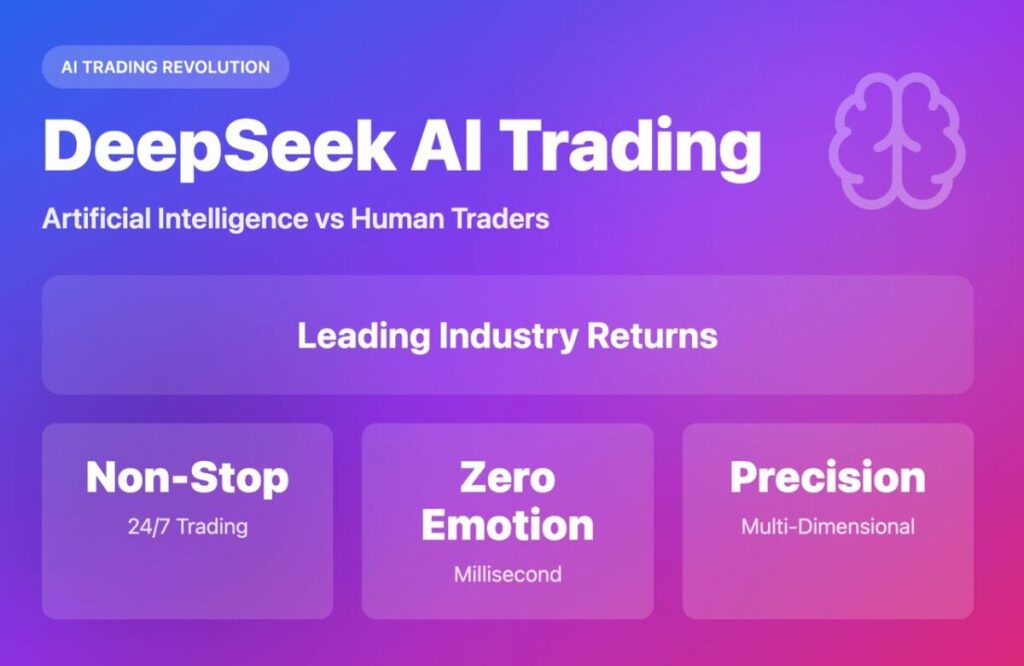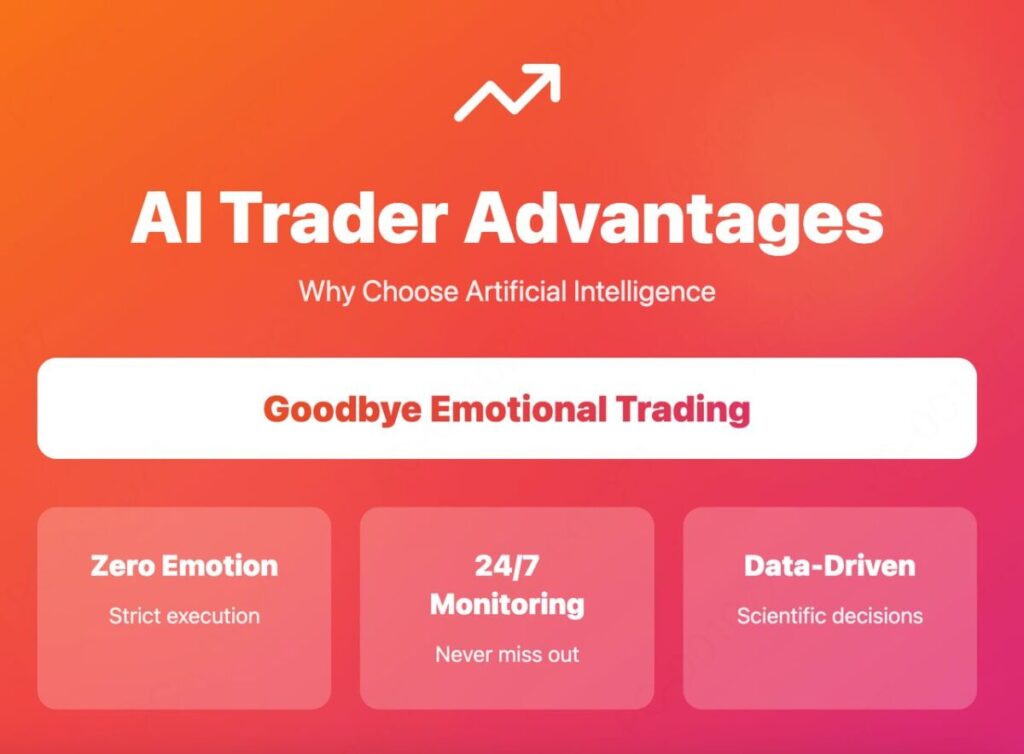
AI copy trading kini menjadi salah satu tren paling menarik di dunia kripto . Artificial intelligence (AI) tidak hanya mengubah cara trader beroperasi, tetapi juga membuka jalan bagi investor untuk mendapatkan hasil yang lebih stabil di tengah volatilitas pasar digital.
Artikel ini mengulas bagaimana AI mampu menganalisis ribuan data pasar, memilih trader terbaik, dan mengoptimalkan strategi trading secara otomatis sekaligus membantu kamu mengelola risiko dengan lebih cerdas dan efisien.
Apa itu AI Copy Trading?
AI copy trading adalah sistem otomatis yang memanfaatkan algoritma kecerdasan buatan untuk meniru strategi trader profesional berdasarkan analisis performa dan kondisi pasar secara real-time.
Berbeda dengan copy trading manual yang mengandalkan intuisi dan pantauan pribadi, AI menjalankan semuanya secara objektif tanpa campur tangan emosi atau bias manusia.
Dengan AI, sistem dapat memproses data dari ratusan trader sekaligus: mulai dari win rate, drawdown, gaya trading, hingga rasio risiko dan imbal hasil.
Cara AI Mencari Profit Maksimal

AI tidak hanya menyalin strategi trader, tapi juga mengoptimalkannya agar lebih adaptif terhadap perubahan pasar.
Berikut cara AI membuat copy trading menjadi lebih efisien dan menguntungkan.
1. Seleksi Trader Secara Cerdas
Alih-alih menebak trader mana yang terbaik, sistem AI menilai performa secara mendalam.
Algoritma akan menilai stabilitas profit, mengukur risiko dengan indikator seperti Sharpe Ratio dan Sortino Ratio, serta mencocokkan gaya trading dengan profil risiko pengguna.
AI juga menilai seberapa tangguh trader tersebut di berbagai kondisi pasar.
2. Manajemen Posisi yang Dinamis
AI memiliki kemampuan untuk menyesuaikan ukuran posisi secara otomatis. Ketika performa trader menurun, sistem akan menurunkan alokasi dana.
Ssebaliknya, jika performa membaik dan kondisi pasar mendukung, AI akan meningkatkan eksposur. Pendekatan adaptif ini menjaga keseimbangan antara potensi keuntungan dan perlindungan modal.
3. Pemantauan Risiko Real-Time
Salah satu keunggulan utama AI adalah kemampuannya memantau pasar 24 jam sehari.
Jika terjadi pergerakan ekstrem, sistem bisa memberikan peringatan bahkan menghentikan salinan otomatis untuk menghindari kerugian besar.
Selain itu, AI dapat mendeteksi korelasi berlebih antar trader yang disalin dan menyarankan diversifikasi agar portofolio tetap sehat.
4. Optimalisasi Multi-Strategi
AI memungkinkan investor memiliki kombinasi strategi berbeda dalam satu portofolio — mulai dari trend following dan grid trading, hingga arbitrage dan scalping.
Dengan diversifikasi gaya seperti ini, portofolio dapat tetap produktif di berbagai kondisi market, baik saat volatilitas tinggi maupun rendah.
Langkah Awal Menggunakan AI Copy Trading
Sebelum mulai, penting untuk memahami bahwa kesuksesan dalam AI copy trading tidak hanya bergantung pada teknologi, tetapi juga pada pemilihan platform dan pengaturan strategi yang tepat.
Pilih Platform yang Terpercaya
Tidak semua platform copy trading benar-benar menggunakan AI murni, sebagian hanya memanfaatkan labelnya sebagai strategi pemasaran.
Karena itu, perhatikan hal berikut:
- Teknologi yang terbukti: pastikan platform memiliki tim AI nyata dan bukti algoritma yang dikembangkan sendiri.
- Transparansi data: hasil backtest dan logika algoritma sebaiknya bisa diverifikasi.
- Keamanan dana: pilih platform yang memiliki sistem pengamanan kuat dan pengelolaan API key yang aman.
- Struktur biaya: pahami komponen biaya seperti management fee dan performance fee, serta hitung hasil bersih setelah biaya.
Atur Parameter Sesuai Tujuan Investasi
AI memang otomatis, tetapi tetap perlu diarahkan sesuai gaya dan profil risiko kamu.
Tentukan apakah kamu ingin pendekatan konservatif atau agresif, berapa lama jangka waktu investasimu, serta batas stop loss dan target profit yang bisa diterima.
Penyesuaian awal ini akan membantu AI bekerja optimal sesuai ekspektasi kamu.
Lakukan Evaluasi Rutin
Meskipun AI bekerja 24/7, evaluasi rutin tetap penting agar hasilnya sesuai harapan.
Periksa secara berkala performa trader yang disalin, efisiensi strategi, dan apakah parameter perlu disesuaikan dengan dinamika pasar terbaru.
Risiko yang Perlu Dikenali
Tidak ada sistem yang sempurna, dan hal yang sama berlaku untuk AI copy trading.
Mengenali risiko di awal akan membantumu menggunakannya dengan lebih bijak.
- Ketergantungan berlebihan pada teknologi
AI tidak selalu mampu memprediksi kejadian tak terduga seperti Black Swan events. Gunakan AI sebagai alat bantu, bukan satu-satunya penentu keputusan. - Kurangnya transparansi algoritma
Beberapa platform tidak membuka detail algoritma mereka. Transparansi penting agar pengguna memahami dasar pengambilan keputusan. - Risiko overfitting
Model AI yang terlalu dioptimalkan untuk data historis bisa gagal di kondisi pasar nyata. Pastikan ada bukti hasil live performance, bukan hanya backtest. - Perubahan struktur pasar
Dunia kripto berkembang cepat. Strategi yang efektif tahun ini belum tentu relevan
Tips untuk Memaksimalkan AI Copy Trading
Untuk mendapatkan hasil optimal, gabungkan kekuatan teknologi dengan pemahaman manusia.
Berikut beberapa kiat praktis:
- Kombinasikan analisis AI dengan penilaian fundamental.
AI unggul dalam membaca pola, tapi analisis manusia penting untuk menilai kualitas proyek dan tim pengembang. - Lakukan backtest sebelum terjun langsung.
Uji portofolio di berbagai kondisi pasar untuk memastikan strategi cukup tangguh. - Diversifikasi strategi dan platform.
Jangan taruh semua dana di satu sistem AI. Sebar risiko di beberapa strategi berbeda. - Pantau pembaruan algoritma.
Platform AI yang kredibel rutin memperbarui modelnya agar tetap relevan dengan kondisi pasar terbaru. - Tetapkan ekspektasi realistis.
Target hasil tahunan di kisaran 15–30% jauh lebih sehat dan berkelanjutan dibanding mengejar profit ekstrem.
Arah Masa Depan AI Copy Trading
Dengan kemajuan teknologi, AI akan semakin cerdas dan personal. Kombinasi deep learning dan reinforcement learning akan memungkinkan AI memahami pola pasar tanpa aturan tetap.
Integrasi data on-chain seperti aktivitas whale, arus dana di DeFi, dan tren NFT akan memberikan insight lebih luas.

Selain itu, analisis sentimen berbasis NLP (Natural Language Processing) akan membantu AI membaca emosi pasar dari media sosial dan berita. Ke depan, strategi AI akan sepenuhnya disesuaikan dengan profil setiap pengguna, menciptakan pengalaman investasi yang benar-benar personal.
Pertanyaan Umum (FAQ)
- Apakah AI copy trading cocok untuk pemula?
Sangat cocok. AI membantu pemula menemukan trader berkualitas tanpa perlu pengalaman mendalam. Mulailah dengan modal kecil untuk memahami sistemnya. - Berapa biaya yang dikenakan oleh platform AI copy trading?
Biasanya berkisar antara 0,5%–2% management fee dan 10%–20% performance fee. Selalu hitung hasil bersih setelah biaya. - Apakah AI bisa menjamin profit?
Tidak. AI meningkatkan peluang sukses, tetapi pasar kripto tetap penuh risiko dan volatilitas tinggi. - Bagaimana cara memastikan AI di platform benar-benar nyata?
Periksa whitepaper, hasil verifikasi performa, atau lisensi teknologi. Hindari platform yang menjanjikan profit besar tanpa transparansi teknis.
Kesimpulan
AI copy trading membuka babak baru dalam investasi kripto. Dengan kemampuan menganalisis, memantau, dan menyesuaikan strategi secara otomatis, AI membantu investor mendapatkan hasil lebih stabil dengan risiko yang lebih terukur.
Namun, teknologi tetap hanya alat, investor perlu memahami prinsip dasarnya, mengatur ekspektasi dengan realistis, dan terus belajar dari data serta pengalaman. Dengan disiplin, strategi yang tepat, dan pemanfaatan teknologi cerdas, AI copy trading bisa menjadi mitra yang membantu kamu tumbuh di dunia kripto yang kompetitif dan dinamis.
Join MEXC and Get up to $10,000 Bonus!
Sign Up

